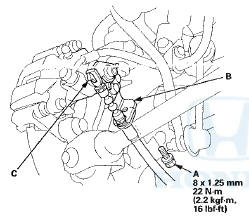 Honda Accord: Rear Brake Disc Replacement
Honda Accord: Rear Brake Disc Replacement
NOTE: Keep any grease off the brake disc and the brake pads.
1. Raise and support the vehicle (see page 1-13).
2. Remove the rear wheel.
3. Release the parking brake lever fully.
4. Loosen the parking brake cable adjusting nut (see page 19-8).
5. Remove the flange bolt (A) from the arm (B).

6. Disconnect the parking brake cable from the lever (C).
7. Remove the brake hose mounting bolt (A).

8. Remove the brake caliper bracket mounting bolts (B), and remove the caliper assembly (C) from the knuckle. To prevent damage to the caliper assembly or brake hose, use a short piece of wire to hang the caliper assembly from the undercarriage. Do not twist the brake hose and the parking brake cable excessively.
NOTE: Make sure the washers (D) are in position on reassembly, if they are removed (see step 8 on page 18-39).
9. Remove the brake disc flathead screws (A),

10. Remove the brake disc (B) from the hub bearing unit.
NOTE: If the brake disc is stuck to the hub bearing unit, thread two 8 x 1.25 mm bolts (C) into the brake disc to push it away from the hub bearing unit. Turn each bolt 90 degrees at a time to prevent the brake disc from binding.
11 . Install the brake disc in the reverse order of removal, and note these items: - Adjust the parking brake (see page 19-8).
- Before installing the brake disc, clean the mating surfaces between the hub bearing unit and the inside of the brake disc.
12. Inspect the brake disc runout (see page 19-33).
13. After install the brake caliper, make sure the clearance between the lower arm B and the parking brake cable is more than 5 mm (0.20 in).
14. Clean the mating surfaces between the brake disc and the inside of the wheel, then install the rear wheel.
 Rear Brake Disc Inspection
Rear Brake Disc Inspection
Runout
1. Raise and support the vehicle (see page 1-13).
2. Remove the rear wheels.
3. Remove the brake pads (see page 19-31),
4. Inspect the brake disc to wheel surface for damage
and cracks ...
 Rear Brake Caliper Overhaul
Rear Brake Caliper Overhaul
Frequent inhalation of brake pad dust, regardless of material composition,
could be hazardous to your health.
- Avoid breathing dust particles.
- Never use an air hose or brush to clean brake ...
See also:
Shift Lock System Circuit
Troubleshooting
1. Connect the HDS to the DLC (A) located under the
driver's side of the dashboard.
2. Turn the ignition switch to ON (II). Make sure the HDS
communicates with the PCM. If it does not, go to the
...
Visual Index
...
A/C Compressor Relief Valve
Replacement
1. Recover the refrigerant with a
recovery/recycling/charging station (see page 21-80).
2. Raise the vehicle on a lift.
3. Remove the relief valve (A) and the O-ring (B). Plug
the opening to k ...
